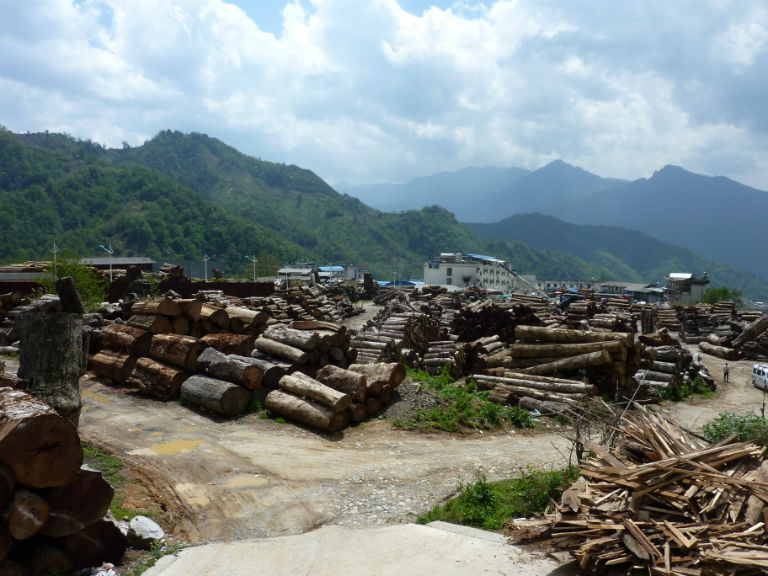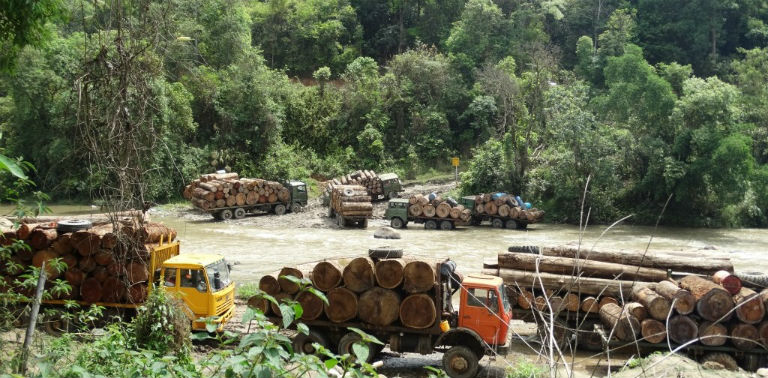- Between 1990 and 2015 Myanmar lost nearly 15 million hectares of forest and other wooded land.
- Approximately 527 mainly UN-led forest user groups manage around 40,000 hectares of in-country forest.
- Illicit cross-border trade of illegal timber continues despite the logging ban set to expire in April 2017.
YANGON – Myanmar’s forests are rich. They are rich in variety, in natural resources, and in wildlife. But they are also rich in danger.
“Myanmar’s forests are more in crisis than ever before,” said Faith Doherty, lead forest campaigner at the UK-based Environmental Investigation Agency. “If you just look at what’s happened in the last five years, natural resources are one of the biggest issues this country is facing.”
The crisis is not new.
According to the UN’s Food and Agriculture Organization (FAO), which tracks forest cover globally, in 2010 Myanmar had the third-highest rate of forest reduction in the world. Only Brazil and Indonesia rank higher.
Between 1990 and 2015, the country lost nearly 15 million hectares of forest and other wooded land. Since 2010, half a million hectares of forest has been lost every year, or an area about the size of Brunei. In total, there are 29 million hectares of forest still standing in the country, and the FAO suggests that this means that just under half of Myanmar is still covered in forest (43 percent) and wooded land (23 percent).
In particular, there are large, globally significant expanses of forest in Tanintharyi, in the south of the country, and in Kachin, Shan and Sagaing divisions in the north, but as FAO puts it: “Time is running out as deforestation continues at a rapid pace.”

For Myanmar, losing its forests would spell catastrophe on several different levels, from exacerbating the effects of climate change – already a huge threat, which only promises to worsen – to the loss of habitat for animals and livelihood for humans.
Around 70 percent of Myanmar’s rural population, around 30 million people, rely on the forests for their basic needs in some way, and wood is the most common rural fuel source.
Saw Htun, deputy country director at the Wildlife Conservation Society in Myanmar, said protecting the forests is critical.
“Myanmar is one of the most important biodiversity hotspots on earth, from the Himalayas to the tropical rainforest down south,” he said.
“For the long-term existence of human beings on this planet, and to maintain a functional, healthy ecosystem, we must protect our forests.”
But the threats to the forests in Myanmar are manifold, from excessive logging both legal and illegal, to clearance for agriculture or other development.

In fact, the threats are so serious that even the government is listening. It put in place a one-year logging ban this summer, which will be lifted in April 2017. Myanmar’s previous military-backed government put in place the first real attempt to address the issues with logging with a ban on timber exports in 2014.
Yet as EIA’s Doherty explains, there are various complications.
“What we have here is increased pressure on the forests in that they are being commercially used for so many different reasons,” said Doherty. “Rampant illegal logging still exists, we still have China’s ferocious appetite for teak and hardwoods from Myanmar, and then all of these countries that want to dig in the ground.”
This means that it is not just this generation of trees under threat.
“There’s timber extraction but once the timber is gone, there’s mineral extraction, then there are other driving forces, such as forest conversion for plantations,” said Doherty.
“So the forests are really in crisis. It’s not a positive message, but it’s the truth.”
Precious wood and conflict
Back in the 1850s, when Myanmar (then Burma) was part of the British Empire, a robust forest management system was put in place. And while the profits from Burma’s bounteous teak and hardwood supplies went to British coffers and not Burmese, the system did at least seem to protect the future of the source of those profits: the trees.
However, after independence in 1948 and a slide into decades of isolation under a brutal military junta, the same could no longer be said of the system. Instead, “Burma’s rich forest resources have lined crony pockets for decades,” as it was bluntly described in a 2014 British government report.
Things have improved for Myanmar’s citizens since the junta handed over power to a military-backed government in 2011, a moment which marked the start of the country’s journey towards diplomacy and a re-entry onto the world stage.
But it has not been quite the same story for the forests.
State ownership and corruption
All forests, whether they are classed as reserved forests, protected public forests, or unclassed, are owned by the state of Myanmar and overseen by the Ministry of Environmental Conservation and Forestry.
Logging is run by a government-owned monopoly, Myanmar Timber Enterprise (MTE). More than one EU-backed report has shown that the system remains wide open for corruption, involving either companies with ties to the same cronies as in the junta-era, the Burmese military, or ethnic armies.
Yet that isn’t the biggest problem. Myanmar’s timber trade is massive, with demand from China and India leading the way, followed by markets including the EU and US, which have some trade restrictions in place. In total, the wood trade is officially worth $550 million a year, according to the World Bank’s most recent figures.
However, experts suggest that figure makes up only around one quarter of the actual total, because 75 percent of timber exports from Myanmar are not official, and in fact they are actually illegal.
Some illegal trade takes place in areas outside the control of the government, where ethnic conflicts are still under way. Indeed, many of these ethnic conflicts are actually linked to who has ownership rights over natural resources like forests.

It is a particularly serious problem in Kachin State, which borders the Chinese province of Yunnan. China is the world’s biggest illegal wood importer.
Trade in timber products, mainly logs, between Myanmar and China reached record levels in 2013, according to the findings of an EIA investigation. Of that trade, 94 percent came through the customs office in Yunnan, meaning it was transported overland across the border with Kachin State in contravention of Myanmar’s forest laws and China’s official policy changes.
Glimmers of hope
But amid all of this grim data, there are signs of hope for Myanmar’s forests. In 2015, the country held its first democratic election for decades, bringing human rights icon Aung San Suu Kyi and her party, the National League for Democracy (NLD), to power.
In the summer of 2016, the new government put a one-year countrywide logging ban in place, and a 10-year ban in the densely-forested Pegu Yoma region, building on the previous administration’s ban on raw timber exports, established in 2014.
Experts cautiously welcomed the ban, which was later scheduled to be lifted in April 2017.
“Myanmar’s timber trade has been fraught with problems for decades, including contributing to the armed conflict in ethnic minority territories,” said Kerstin Canby, director of Forest Trends’ Forest Policy, Trade and Finance Program. “Reform is critically needed to make the sector environmentally and economically sustainable, as well as socially equitable, and to ensure that it contributes to peace rather than war.”
Canby added that the pause in official logging could represent a chance to put stronger, more effective policies in place.
“This moratorium could represent a good stopgap measure, if it is used to allow time for the national government to make necessary institutional reforms.”
However, she said more work needs to be done, particularly on illegal logging, to really ensure that Myanmar moves toward a better future for its forests. It’s not just about a ban, but better governance, the inclusion of all stakeholders, and tackling the problem at its source: the demand from trading partners.
“In order to be a step toward meaningful change, the moratorium must be tied to key reforms in the sector that must be implemented before the resumption of logging,” said Canby.
There are other positive steps being taken in Myanmar, including high-level discussions over a new forest law to replace the old version, and even the reform of the logging company, the MTE. Its director Saw John Shwe Ba told Mongabay this was welcome.
“Just like neighboring countries, the logging ban is a good thing to reduce the dependency on natural forests and to get a chance for reforming as well, I think,” he said.
Global help
The international community and trading partners are working with Myanmar too. Illegal trade with China has dropped from its 2013 peak, when 1.7 million cubic meters of timber products worth $621 million were imported by China from Myanmar. As aforementioned, an EIA investigation has shown that 94 percent of this 2013 trading was likely to have been illegal.
The European Union began a project in 2014 to prepare Burmese civil society to engage in the development of a Forest Law Enforcement Governance Trade (FLEGT) process for Myanmar. The FLEGT process could represent the first steps toward a system which could mean full European trade with Myanmar’s logging industry.
Community forestry initiatives are also being tested, with around 527 mainly UN-led forest user groups managing around 40,000 hectares of forest at the latest count, and the UN’s REDD+ program, which Myanmar joined in 2011, also under way.
Representatives are advocating at the ministerial level to try to implement change, as well as leading capacity-building training on sustainability forestry management and effective management tools, including the use of satellite imagery.
In April, the UN reiterated its commitment to Myanmar’s forest sector, describing collaboration between Myanmar and the UN as something that “represents hope for the future.”
Civil society
Activists remain watchful. For Burmese environmentalists, it’s not a moment too soon.
Devi Thant Cin runs the Myanmar Green Network and believes now is the moment to save Myanmar’s forests – and its future.
“The cronies cut down our forests. The government gave them permission, and all the money is now in their pockets,” she said. “Think of parts of Myanmar – the mountains are gone, the trees are gone, the rivers are damaged. It is all poisoned. Every season now we have flooding.”
“It all depends on the new government. We must cure this now.”
Photo: Truck carrying logs across Myanmar’s river border with Zizhi Yunnan, China, in 2012. Photo courtesy of Environmental Investigation Agency
Sources:
